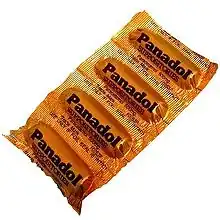Suppository
A suppository is a dosage form used to deliver medications by insertion into a body orifice where it dissolves or melts to exert local or systemic effects. There are three types of suppositories, each to insert into a different sections: rectal suppositories into the rectum, vaginal suppositories into the vagina, and urethral suppositories into the urethra of a male.
Suppositories are ideal for infants, elderly individuals and post-operative patients, who are unable to swallow oral medications, and for individuals experiencing severe nausea and/or vomiting.[1][2][3]
Composition
Several different ingredients can be used to form the base of a suppository: cocoa butter or a similar substitute, polyethylene glycol, hydrogels, and glycerinated gelatin. The type of material used depends on the type of suppository, the type of drug, and the conditions in which the suppository will be stored.[4]
Rectal suppositories
In 1991, a study on suppository insertion in The Lancet found that the "torpedo" shape helps the device to travel internally, increasing its efficacy.[5] The findings of this single study have been challenged as there is insufficient evidence on which to base clinical practice.[6] Rectal suppositories are intended for localized or systemic action to relieve pain, constipation, irritation, inflammation, nausea and vomiting, fever, migraines, allergies, and sedation.[7][8]

Urethral suppositories
Alprostadil pellets are urethral suppositories used for the treatment of severe erectile dysfunction (impotence). They are marketed under the name Muse in the United States.[9] Its use has diminished since the development of oral impotence medications.
See also
| Wikimedia Commons has media related to: Suppository (category) |
Notes
- ↑ Jannin, Vincent; Lemagnen, Gilles; Gueroult, Pascale; Larrouture, Denis; Tuleu, Catherine (2014-06-30). "Rectal route in the 21st Century to treat children". Advanced Drug Delivery Reviews. Drug delivery and the paediatric population: where are we at?. 73: 34–49. doi:10.1016/j.addr.2014.05.012. ISSN 0169-409X. PMID 24871671.
- ↑ "Dulcolax 5 mg Suppositories - Summary of Product Characteristics (SmPC) - (emc)". www.medicines.org.uk. Retrieved 2021-12-11.
- ↑ Contributor, N. T. (2016-02-22). "Rectal drug administration in adults: how, when, why". Nursing Times. Retrieved 2021-12-11.
{{cite web}}:|last=has generic name (help) - ↑ Troy, David B.; Beringer, Paul (2006). Remington: The Science and Practice of Pharmacy. Lippincott Williams & Wilkins. pp. 884–885. ISBN 9780781746731.
- ↑ Abd-El-Maeboud, K. H.; T. El-Naggar; E. M. M. El-Hawi; S. A. R. Mahmoud; S. Abd-El-Hay (28 September 1991). "Rectal suppository: commonsense and mode of insertion". The Lancet. 338 (8770): 798–800. doi:10.1016/0140-6736(91)90676-G. PMID 1681170. S2CID 23190075.
- ↑ Bradshaw, Ann; Lynda Price (20 December 2006). "Rectal suppository insertion: the reliability of the evidence as a basis for nursing practice" (PDF). Journal of Clinical Nursing. 16 (1): 98–103. doi:10.1111/j.1365-2702.2005.01519.x. PMID 17181671. Archived from the original (PDF) on 2020-02-29.
- ↑ Hua, Susan (2019-10-16). "Physiological and Pharmaceutical Considerations for Rectal Drug Formulations". Frontiers in Pharmacology. 10: 1196. doi:10.3389/fphar.2019.01196. ISSN 1663-9812. PMC 6805701. PMID 31680970.
- ↑ "ANTIBIOTIC/ANESTHETIC/STEROID - RECTAL SUPPOSITORIES side effects, medical uses, and drug interactions". MedicineNet. Retrieved 2021-12-11.
- ↑ "Muse Suppository - Facts and Comparisons". Drugs.com. Retrieved 4 January 2013.
References
- Doyle, D., "Per Rectum: A History of Enemata", Journal of the Royal College of Physicians of Edinburgh, Vol.35, No.4, (December 2005), pp. 367–370.
- Payer, L., "Borderline Cases: How Medical Practice Reflects National Culture", The Sciences, Vol.30, No.4, (July–August 1990), pp. 38–42.

-solution.jpg.webp)

